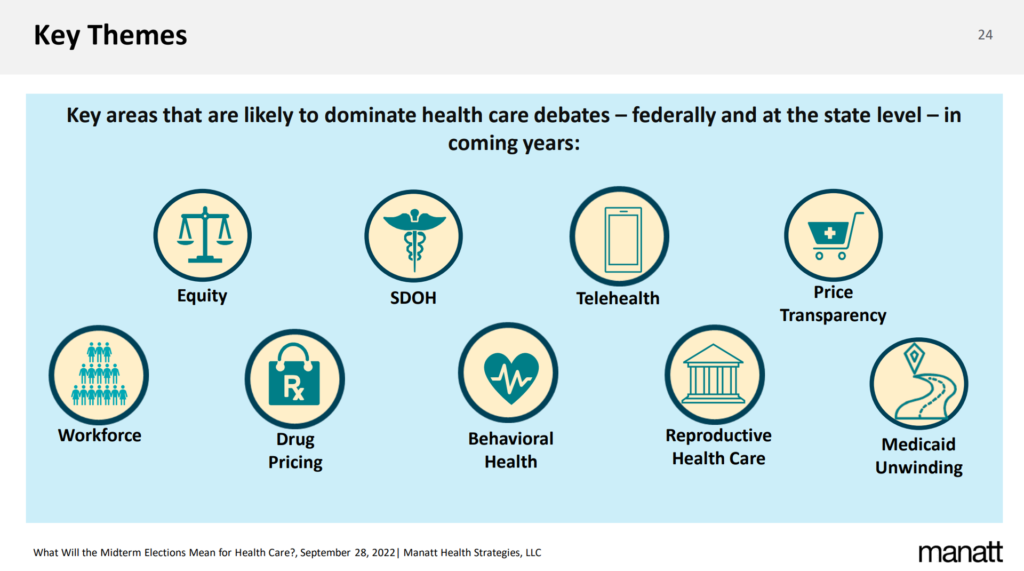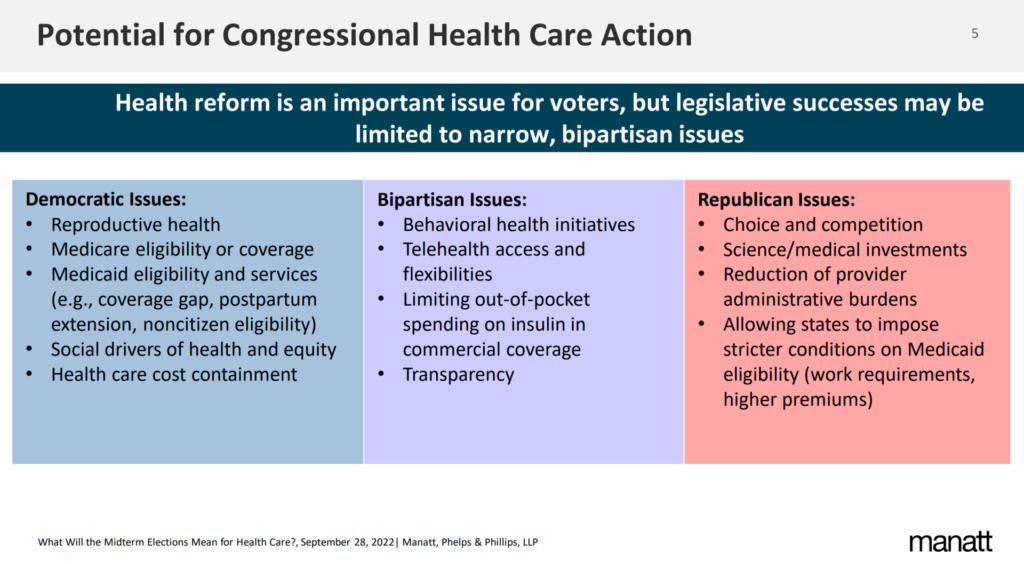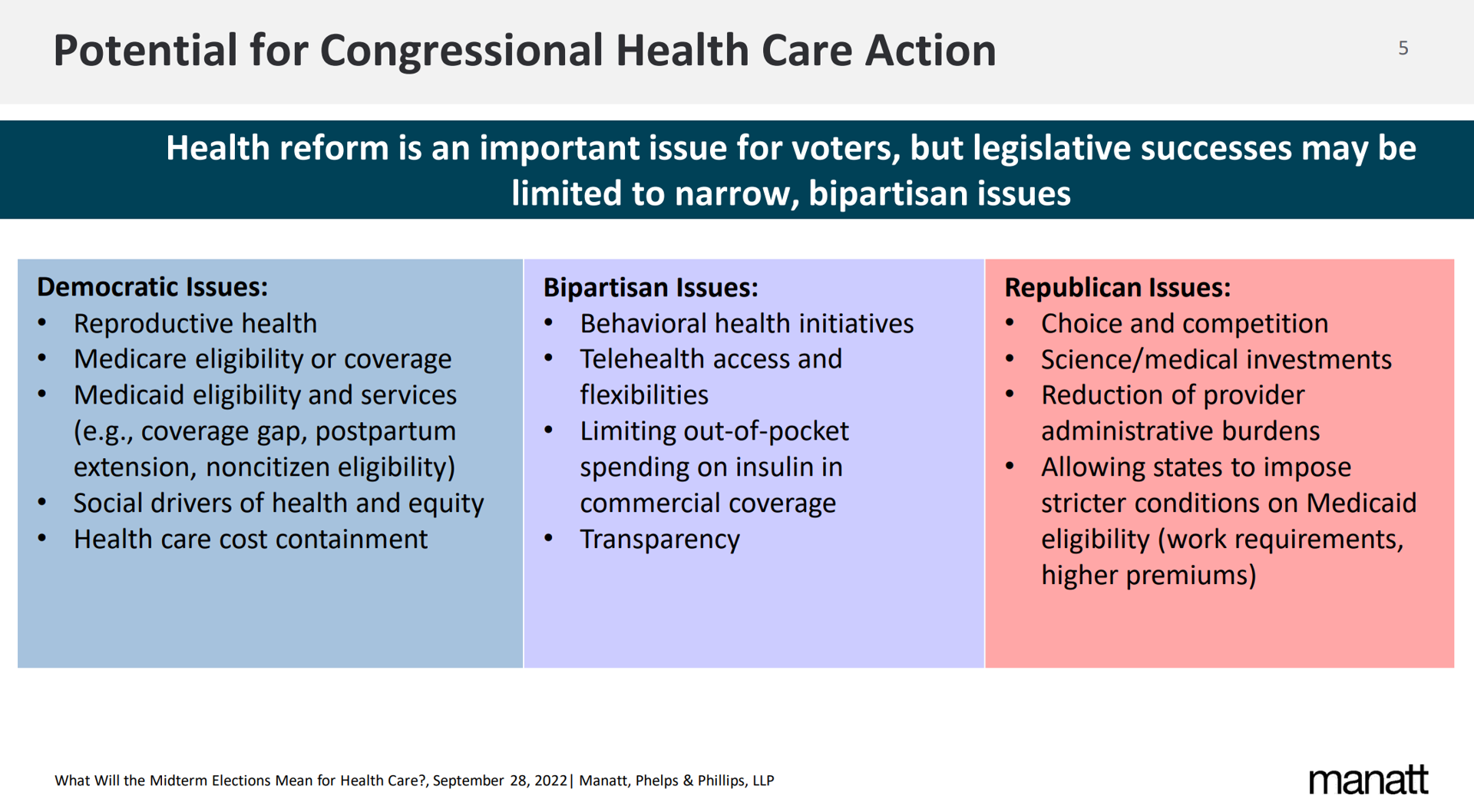On Tuesday November 8, 2022, health and medical issues will be on many U.S. voters’ minds as they enter voting booths to select representatives for the House and the Senate, along with some states’ ballots addressing specific healthcare issues.
Health policy experts from Manatt, Phelps & Phillips, AARP, and the United States of Care recently shared perspectives on the health care issues on voters’ and policy makers’ minds for the 2022 midterm elections. This post synthesizes their analyses as we lead up to what will be a pivotal election for Americans’ public health, individual well-being, and access to care.

Federal elections shape national health policy, but state elections are just as important in the current health policy environment, the team from U.S. of Care pointed out in a webinar collaboration on October 12.
“States are where policymaking happens at a pace much faster than at the federal level,” they noted. For health policy, the state action for the 2022 midterms will be on abortion and reproductive health access along with Medicaid expansion (with the Affordable Care Act now safe from Republicans’ long-promised repeal that never happened…for the time being, anyway).

The 2022 midterm elections will be more highly partisan than usual, based on razor-thin margins reported in the latest polls in several key states that could re-shape and dramatically disrupt health care for various populations — whether women or rural dwellers or people under-served for mental health service access, or seniors with Medicare Part D coverage confronting high cost specialty drug prices.
The chart illustrates a handful of health policy priorities at the Federal level that may have bipartisan overlap: namely, telehealth coverage, funding for mental and behavioral health, price transparency (in the law but not yet smoothly working for most patients), and reducing out-of-pocket costs for insulin.
Then you can see the clear chasms between Democrats’ health policy priorities versus Republicans’. Far and away, reproductive health and abortion access ranks very high in Democrat voters’ priorities, along with health equity and access to care. For Republican voters at the Federal level, a call for revisiting Medicare and Social Security on some pace of frequency has been discussed, along with the long-time mantra of “choice and competition” for bolstering markets for health care.
For more specifics, see Manatt’s webinar presentation, What Will the Midterm Elections Mean for Health Care? from September 28, 2022.![]()
Health Populi’s Hot Points: While the overall U.S. economy and inflation rank top of mind for most voters, the ultimate turnout and result for 2022 midterms will be largely driven by voter enthusiasm for a handful of passion-provoking issues.
One area that unites, relatively speaking, Democrat, Independent and Republican voters is drug prices.
The October 2022 KFF Health Tracking Poll just assessed the most important health care issues that could shift key races. “Abortion access and reproductive health is motivating majorities of Democratic women, women of reproductive age, and Democratic and Democratic-leaning voters in states where abortion is currently illegal,” KFF found.
Older voters are quite motivated by the issue of reducing the cost of prescription drugs for people with Medicare, the KFF survey learned. Most voters 65 years of age and older (including both Democrats and Republicans) would be more likely to vote for a candidate who supports the Inflation Reduction Act’s Rx cost caps and to allow the federal government to negotiate medicines prices for people with Medicare.
AARP conducted a poll among its constituents of Americans 50 years of age and older, published October 4. Their conclusion: that women over 50 will be “the difference” for the 2022 midterm U.S. elections.
“As the largest bloc of swing voters heading into the midterms, women voters 50+ can make the difference in 2022 and decide the balance of power in Congress and statehouses across the country,” Nancy LeaMond, AARP Executive Vice President and Chief Advocacy and Engagement Officer, said in her remarks about the survey.
The key findings were that,
- Older women are united in protecting Social Security from cuts in their support for protecting Social Security from cuts
- The top issues for older Republican women were inflation and rising prices, crime , immigration, and election security
- For older Democratic women, top issues were voting rights and threats to democracy, followed by gun violence and abortion
- Among older Independent women voters, key priorities were division in the country, voting rights, threats to democracy, and the economy.
“Women age 50 and over are one of the largest, most reliable group of voters,” AARP has found.
So “She” may indeed make the difference in the slim marginal outcomes of many elections on November 8.





 I'm in amazing company here with other #digitalhealth innovators, thinkers and doers. Thank you to Cristian Cortez Fernandez and Zallud for this recognition; I'm grateful.
I'm in amazing company here with other #digitalhealth innovators, thinkers and doers. Thank you to Cristian Cortez Fernandez and Zallud for this recognition; I'm grateful. Jane was named as a member of the AHIP 2024 Advisory Board, joining some valued colleagues to prepare for the challenges and opportunities facing health plans, systems, and other industry stakeholders.
Jane was named as a member of the AHIP 2024 Advisory Board, joining some valued colleagues to prepare for the challenges and opportunities facing health plans, systems, and other industry stakeholders.  Join Jane at AHIP's annual meeting in Las Vegas: I'll be speaking, moderating a panel, and providing thought leadership on health consumers and bolstering equity, empowerment, and self-care.
Join Jane at AHIP's annual meeting in Las Vegas: I'll be speaking, moderating a panel, and providing thought leadership on health consumers and bolstering equity, empowerment, and self-care.